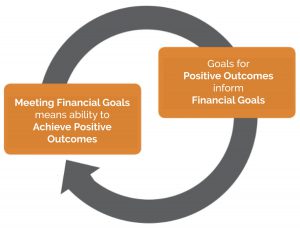Your organization probably has a mission statement and strategies in place for achieving your program goals, but do you also have concrete financial goals? Whether you administer a nonprofit, faith-based organization, or a small business, you have to think about the financial health of your organization.
Your mission and program goals are, by definition, tied to financial goals. Serving your clients and families, as well as paying your staff, requires funding. If you haven’t thought about the health of your current budget or your future financial goals, now is the time! The 4 steps outlined below can guide you.
Step 1: Assess your organization’s finances.
- First, you may need to spend time reviewing your current revenue, expenses, and the quality of your bookkeeping. In this process, engage your leadership team, board of directors, and/or financial consultants.
- If needed, determine how to improve your accounting practices. Keep in mind that accounting and other supportive services are part of what enables your programming to have the desired impact.
- If your organization is not consistently breaking even, then that will inform your financial goals. If your revenue exceeds your costs, how are you reinvesting it in your mission?
Step 2: Set specific goals for your program, such as increasing funding or serving more clients.
- Separate from the process of reviewing your budget, do you have ideas for the future of your program?
- Does your organization have an up-to-date strategic plan? In your planning process, did you start by determining the end results that you want to see?
- What are your plans for program improvement?

- Is your organization looking to replicate its services in another geographic region?
- Did your needs assessment indicate that you should expand to serve a broader range of clients and families?
- What are your plans for program improvement?
- As you are going through the process of turning big ideas into program goals, be sure that you make your goals Specific, Measurable, Attainable, Relevant, and Timely, or SMART.
Step 3: Set financial goals that will enable you to meet your program goals. What will it cost to meet these goals?
- You may have some goals for your organization that do not require additional funding. Perhaps you need to prioritize your current funding and/or staff time.
- Other goals, like serving additional clients, expanding to a new region, and increasing staff wages, do require additional funding.
- Quantify your specific short-term and long-term funding goals. Then, specify how these goals help you achieve your desired outcomes.

Step 4: Develop specific strategies to accomplish your financial goals.
- One possible strategy is decreasing your current costs. Review your spending from the past few years to see if there are opportunities to save money.
- You may find that your organization is using resources for activities that are not as closely tied to your mission as they should be.
- Could you negotiate with any of your vendors for lower service fees?
- Bringing in additional revenue can be a daunting task. Break it down into smaller pieces.
- What type of funding are you already accessing that could be increased?
- Could you raise more from individual or corporate donors?
- Could you increase your fees for services?
- What other funding sources are you not already accessing?
- Could you write a grant for the first time?
- Is there government funding available that supports your field?
- What type of funding are you already accessing that could be increased?
As you assess the overall health of your organization, remember to focus on areas in which your background is not strong. If you are the director of early childhood education program, then your experience and education is likely in the field of child development. You probably have a lot of ideas to improve the quality of education at your program. Also be sure to consult experts in other areas, like finance, to ensure you are making the most impact!
Our team is currently engaged in a project funded by Partnerships for Early Learners, a program of Early Learning Indiana. We are working with 10 early learning programs across Indiana to help them meet their financial goals. Going through this 4-step process is different for each program. The programs are structured differently and bring unique skills to the table. Despite their differences, each program has been able to set specific goals and find funding strategies that will work best for them.
If you’re ready to jump into this process and need some help with goal setting or fund development, contact us at Transform Consulting Group for a free consultation!

